
Polskie Koleje Państwowe S.A. is the dominant railway operator in Poland. The company was founded when the former Polskie Koleje Państwowe state-owned enterprise was divided into several units based on the need for separation between infrastructure management and transport operations. PKP S.A. is the dominant company in PKP Group collective that resulted from the split, and maintains in 100% share control, being fully responsible for the assets of all of the other PKP Group component companies. The group's organisations are dependent upon PKP S.A., but proposals for privatisation have been made.

Hamburg Südamerikanische Dampfschifffahrts-Gesellschaft A/S & Co KG, widely known as Hamburg Süd, is a German container shipping company. Founded in 1871, Hamburg Süd is among the market leaders in the North–South trade. It also serves all significant East–West trade lanes.

Kościuszko was a passenger steamship that was built in Scotland in 1915, sailed as a troopship in both World Wars, was an ocean liner between the wars, carried displaced persons after World War II and was scrapped in England in 1950.

MS Batory was a Polish ocean liner which was the flagship of Gdynia-America Line, named after Stefan Batory, the sixteenth-century king of Poland. She was the sister ship of MS Piłsudski. After Allied wartime service, mainly under the UK Admiralty, she became in 1951 the flagship of the Polish Ocean Lines and the Polish merchant fleet. She is often described as the "Pride of the Polish Merchant Marine". Batory along with her sister Piłsudski were the two most popular ocean liners of Poland.

MS Piłsudski was a medium-size ocean liner of the Polish Merchant Marine, named for Marshal Józef Piłsudski, a national hero of Poland. She was built in Italy by the CRDA yard at Monfalcone, yard number 1126, for Polskie Transatlantyckie Towarzystwo Okrętowe, which in 1934 became Gdynia – Ameryka Linie Zeglugowe, with part of the payment being shipments of coal from Poland. Launched in December 1934, her tonnage was 14,294 tons gross, with a length of 162 metres (531 ft) and beam of 22 metres (71 ft). She was propelled by two diesel engines driving a pair of propellers giving a speed of 18 knots (33 km/h).
MV Fu Shan Hai was a Chinese bulk carrier which on 31 May 2003 was involved in a collision with the Polish container ship Gdynia north-west of the Danish island of Bornholm in the Baltic Sea. Later the same day Fu Shan Hai sank in 69 metres (226 ft) of water. At that moment, she was the biggest ship to be sunk in the Baltic Sea.

Polska Żegluga Morska known as Polsteam or PŻM, is a cargo ship operator based in Szczecin, Poland. Polsteam is a state-owned enterprise with around 3,000 employees.
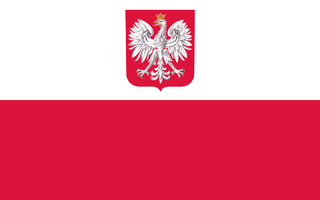
The Polish Merchant Navy was created in the interwar period when the Second Polish Republic regained independence.
The Baltic American Line, was a shipping company, established by the Danish East Asiatic Company in 1920.

Czar, or Царь in Russian, was an ocean liner for the Russian American Line before World War I. The ship was later named Estonia for the Baltic American Line, Pułaski for the PTTO and as a UK Ministry of War Transport troopship, and as Empire Penryn after World War II. The liner was built in Glasgow for the Russian American Line in 1912 and sailed on North Atlantic routes from Libau to New York. On one eastbound voyage in October 1913, Czar was one of ten ships that came to the aid of the burning Uranium Line steamer Volturno.

MS Chrobry was a transatlantic passenger liner, and was the last pre-war new build for the Polish Merchant Navy. She was built for the Gdynia-Ameryka Linie Żeglugowe S.A..

The Moore-McCormack Lines was a series of companies operating as shipping lines, operated by the Moore-McCormack Company, Incorporated, later Moore-McCormack Lines, Incorporated, and simply Mooremack, founded in 1913 in New York City. It ceased trading on its buy-out in 1982. The founders were Albert V. Moore (1880–1953) (director/president) and Emmet J. McCormack (director/treasurer), with Mr Molloy (director/secretary).
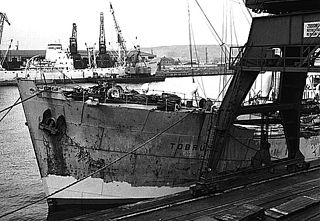
Tobruk was a 7,090 GRT cargo ship which was built in 1941 as Empire Builder by William Gray & Sons Ltd for the Ministry of War Transport (MoWT). On completion she was handed over to the Polish government-in-exile and renamed Tobruk. She was a member of a number of convoys during the Second World War. She was sold in 1951 to Polskie Linie Oceaniczne and served until 1967. She was scrapped in 1968.
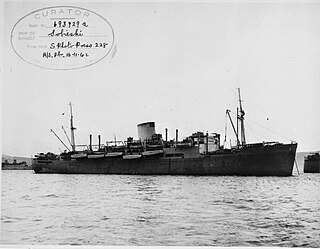
MS Sobieski was a Polish passenger ship launched in 1939. It was constructed for the South American service of the Gdynia-America Line – GAL to replace the aging SS Kościuszko and SS Pulaski. She was named in honour of the Polish king Jan III Sobieski. The MS Sobieski was to be a sister ship to the MS Chrobry.

Deutsche Ost-Afrika Linie was a shipping line, established in 1890 as an alternative to the existing shipping services to East Africa, including German East Africa (1891–1919), then dominated by United Kingdom shipping lines.

Polish Ocean Lines is a Polish commercial shipping company, with headquarters in Gdynia. The company was created in 1951 in a merger of three smaller shipping companies. Currently, PLO acts as a holding company for 12 other shipping companies.
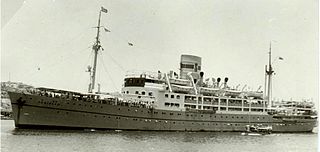
Jagiełło was a medium-sized passenger-cargo ship, sailing under the Polish flag between 1948 and 1949, and then decommissioned due to unprofitable and post-war political conditions, which were not conducive to the development of the Polish passenger fleet, and then transferred to the Soviet Union as Pyotr Velikiy, operating Black Sea passenger services until 1973. The ship had been built by Blohm & Voss for Turkish operators, taken over after completion by the German government. After World War 2 it taken over by the British and then the Soviet Government.
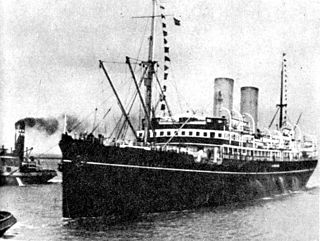
Polonia was a passenger steamship that was built in Scotland in 1910, originally named Kursk and was registered in the Russian Empire. She was an Allied troopship in the First World War, when she was briefly operated by Cunard Line. After the war she returned to civilian passenger service, in Latvian service until 1930 and then for Poland.
















